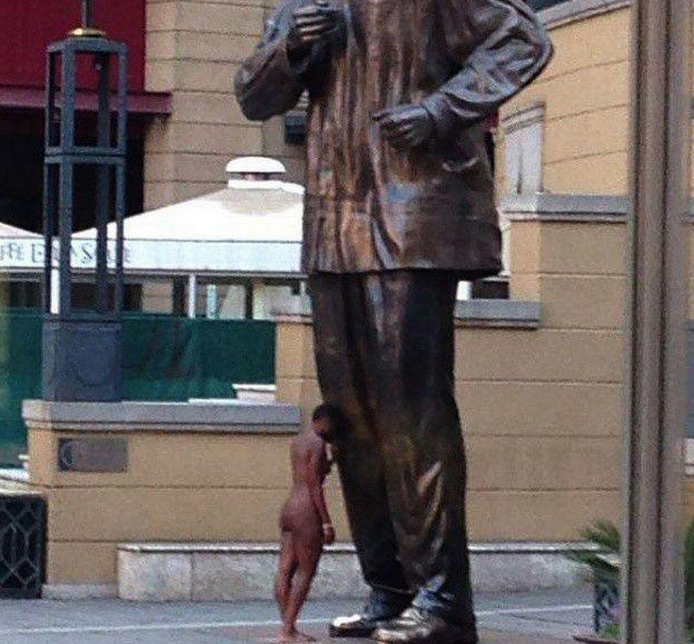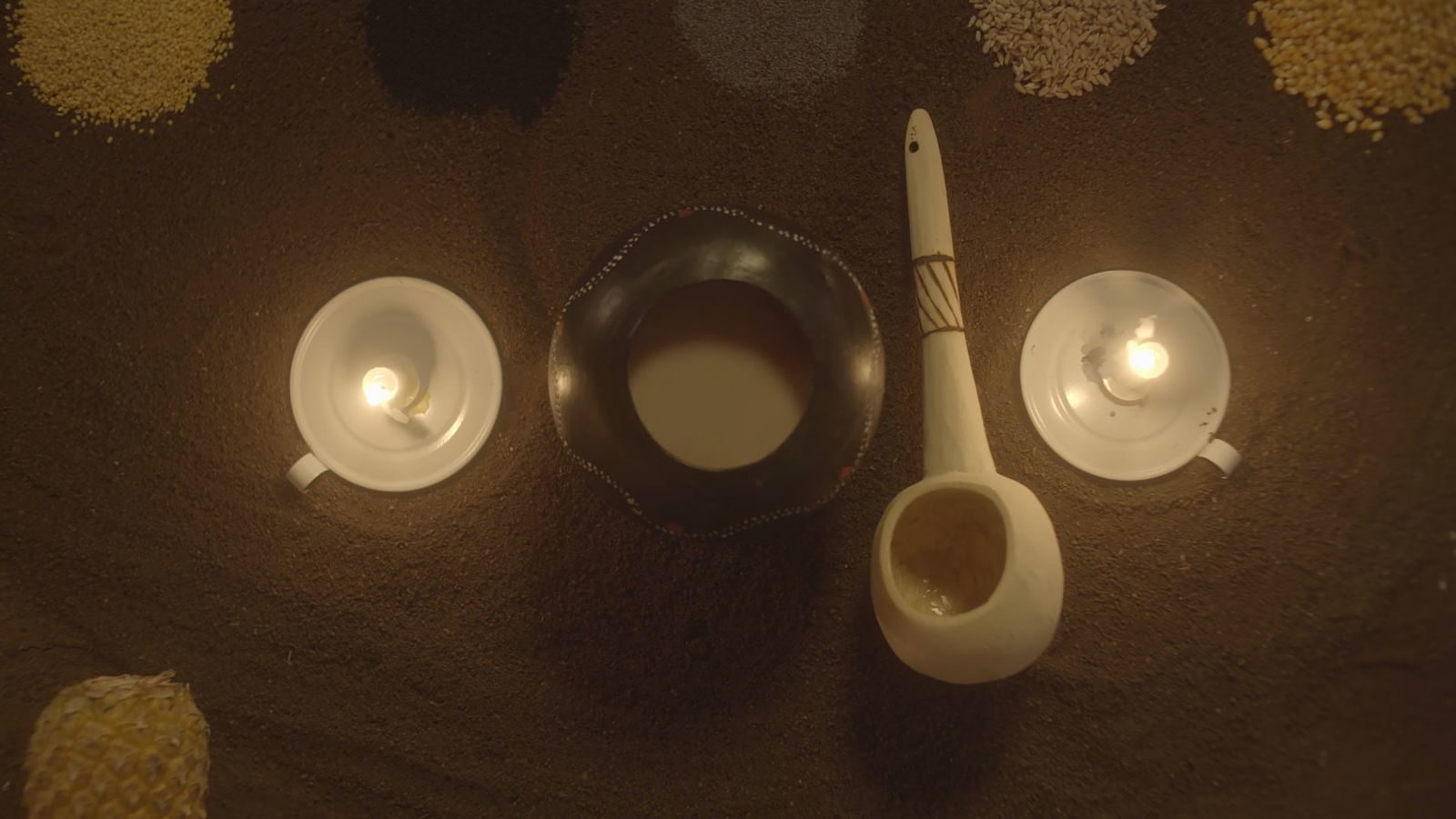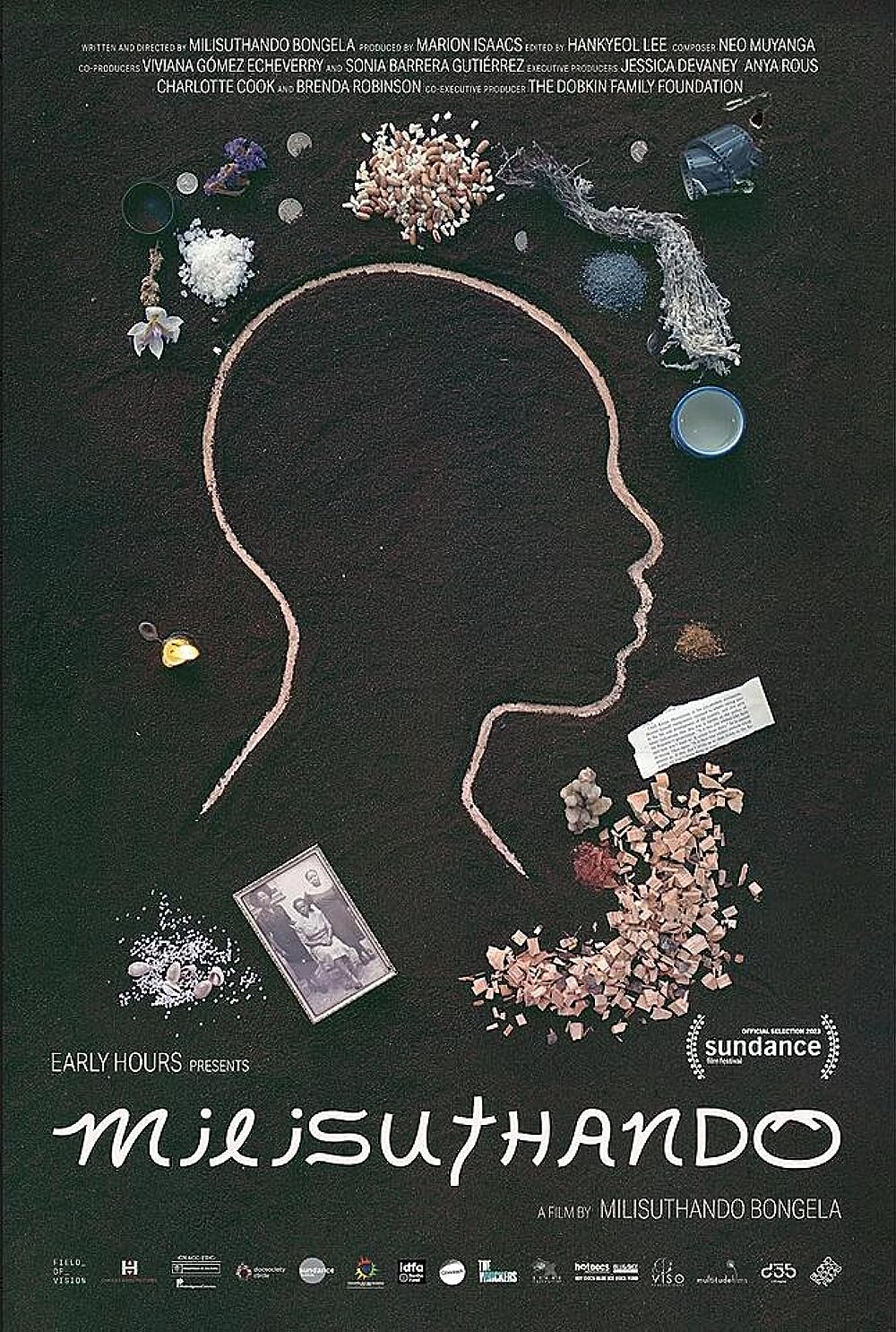The director’s grounding in the principles of literature is immediately apparent. Milisuthando, the film, is structured over five chapters. Throughout, there’s an interweaving of devices, recurrent motifs, a playful use of cue and reference, supple vocabulary, and — most interesting in this genre of the personal essay — journalism’s mantras of ‘show, don’t tell’ and the ‘right of reply’.
Over two hours there is a lot we are told through being shown, and for some, the space provided for response by the presumed antagonists is deleterious, but here I argue that it is necessary. Milisuthando tells a South African story, and befittingly that story is durational, confusing, and discordant.
What we’re shown first is the strangeness of our current predicament through Mystery Braveheart, the unidentified woman who undressed to share a tender moment with Nelson Mandela’s statue in Sandton City, during the peak of corporate foot traffic. After resting her head on the statue’s knee, in what appears to be in full control of her faculties, she reclothes and continues with her day. The grainy footage is enough to display the unstable lines between adoration and idolatry, belonging and alienation, psychosis, and self-authority, and how these are further complicated by the brute necessities of life under capital — in a world reeling from apartheid.

Image courtesy of Internet archives
The strangeness of our arrival at this place, however, is shown less allusively but as acutely. Having couched our confusion with the statement, ‘the street I grew up in had no name. And is in a country that no longer exists,’ Milisuthando Bongela retells the story of the Transkei with the help of her uncle. Using cartographic studies demarcating ‘Bantustans’, videos from UN Assemblies in the 1970s, and archival footage of Chief Matanzima, we see the lengths that were undertaken for the semblance of self-governance under fascism. When asked why he’d cede to apartheid laws and make a republic in a republic, the optimistic statesman says, ‘in a multiracial society we are treated with contempt. But once we are separated, they will treat us with respect, knowing that these men come from another state.’
Illuminating his attempts at statecraft is a procession during a ceremonial display of national athletics. A uniformed, multiracial group sings a well-rehearsed anthem with hands over chests under a flag of blue, white and orange. Black children are seen doing synchronised routines in front of army men and older women doing traditional dances, ending with a lone torchbearer lighting his pyre triumphantly from a scaffolded bleacher. It is a night-time scene of historical earnestness, but it becomes an introduction to the machinations of violence with another procession choreographed deftly to mirror this one.
This dizzying sequence follows twelve minutes later to elaborate on what the narrator has described as ‘apartheid’s wish’. Reflecting the earlier scene, archival footage is also used. Following the words of Mr Prinsloo (a representative from the Native Affairs department under Hendrik Verwoerd) about black and white cultures being ‘flowers’ that need separate preservation, blooms are used as punctuation here. White people on vehicles, and others crouching as if condescending to children, speak to seated black women weaving baskets. Others still are filmed filming ethnographically tailored scenes to create a believable distance between ‘the civilised’ and ‘the primitive’. The processions here are parades with aircraft formations and elaborate gymnastics displays. Banners fly with the words ‘Believe in god, believe in your people, believe in yourself’. It is another realm entirely, a systemically fabricated land of milk and honey. The depicted excesses are silken, tailored and baroque. Moreover, their beneficiaries appear elated at their participation, whether at the steps of the Voortrekker monument or in the foothills of Devil’s Peak, while burning film, eating dessert, or brandishing rifles.
In this singular example of the film’s methodical attempt at ‘showing’ — accompanied by a score that moves from sweeping orchestral strings to churning elegy — we are offered the insight that how we arrived here was not just an economic equation, nor simply a matter of hate against Black but a perversity of love. We are reminded that it was from an ardent pursuit for all that is and all who are White that the genocidal seeds sown are still laying their rotten fruit.
The ‘right of reply’ shows itself in the film’s last chapters, through how the descendants of these beneficiaries live with this reality. In veiled conversations with close friends and dramatic re-enactments of the dilemmas of their ‘white ancestors’ — both of which are articulations of genuinely felt pain — there is a deafness and obfuscation. The film opens a window in which, even in the midst of profound kinship, there is a leverage of lived — however unspoken or misunderstood — power that still extracts reassurance from those grappling with belonging. Even here we are shown — not told — that perhaps to live in a world made for you, taken from its true custodians, distorts sense and sensitivity.

However, this film is not just a story about race and racism. The narrator says early, ‘that’s the fascinating thing about my country, even against the backdrop of utter madness, the basic details of human life find a way to exist and exist well.’ Milisuthando is an offering for everyone navigating the fact of Being in a context shaped by a failed project of reconciliation. It is all for anyone who might be drowning in a world that is still leaking from where it was carved. In Bongela’s tender and reverential treatment of her network of family connections, in her celebration of the sophisticated armature of Black spiritual life, in allowing her privileged, anomalous context to be an accessible metric to judge from, project on, baulk against and resonate with, the film provides a new way of resuming the stale and uncomfortable conversations that get more urgent with every generation.
The stars of this production include her grandmother’s effervescent wit, the friends that chuckle during their exhausted yearning, and school kids with a too-keen awareness that they are seen as non-people, and with all this we are led to consider that the catalyst for radical shift isn’t just in the Molotov cocktail, it can also reside in the opportunity for sincere engagement. This filmic text is an important entry into South African film. For this reader, it is a powerful aid against the hypnosis of forgetting, and a place from which to begin again.




















































